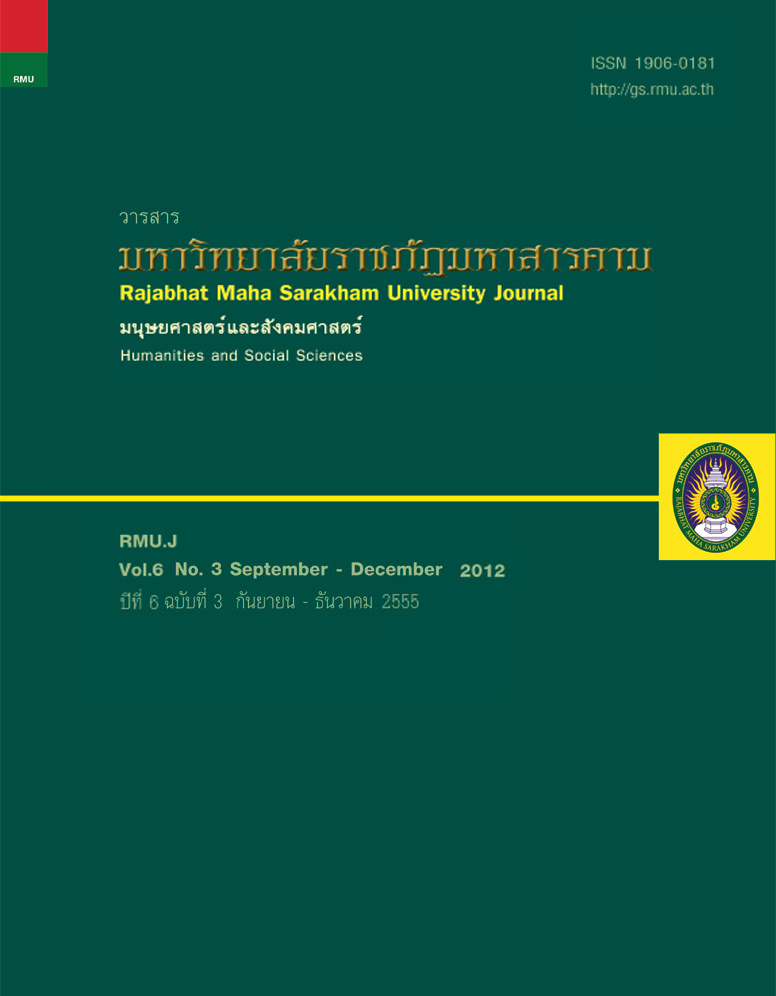การสร้างแบบวัดความสามารถในการคิดวิเคราะห์ สาระการเรียนรู้วิทยาศาสตร์ ชั้นมัธยมศึกษาปีที่ 3
Main Article Content
บทคัดย่อ
บทคัดย่อ
การวิจัยครั้งนี้มีวัตถุประสงค์ ประการแรก เพื่อสร้างแบบวัดความสามารถในการคิดวิเคราะห์สาระการเรียนรู้วิทยาศาสตร์ ชั้นมัธยมศึกษาปีที่ 3 ประการที่สอง เพื่อหาคุณภาพของแบบวัดความสามารถในการคิดวิเคราะห์สาระการเรียนรู้วิทยาศาสตร์ ชั้นมัธยมศึกษาปีที่ 3 ประการที่สาม เพื่อสร้างเกณฑ์ปกติของคะแนนความสามารถในการคิดวิเคราะห์สาระการเรียนรู้วิทยาศาสตร์ ชั้นมัธยมศึกษาปีที่ 3 ในโรงเรียนสังกัดสำนักงานเขตพื้นที่การศึกษามหาสารคาม เขต 3 กลุ่มตัวอย่างที่ใช้ในการวิจัย ได้แก่ นักเรียน ชั้นมัธยมศึกษาปีที่ 3 ที่กำลังศึกษาในภาคเรียนที่ 2 ปีการศึกษา 2553 ในโรงเรียน สังกัดสำนักงานเขตพื้นที่การศึกษามหาสารคาม เขต 3 จำนวน 347 คน เครื่องมือที่ใช้ในการวิจัย คือ แบบวัดความสามารถในการคิดวิเคราะห์สาระการเรียนรู้วิทยาศาสตร์ ชั้น มัธยมศึกษาปีที่ 3 กำหนดเนื้อหา หรือสถานการณ์ที่มีความสอดคล้องกับความสามารถในการคิดวิเคราะห์ สาระการเรียนรู้ วิทยาศาสตร์ ชั้นมัธยมศึกษา ปีที่ 3 สามารถวัดได้ครอบคลุมองค์ประกอบของการคิดวิเคราะห์ตามนิยามเชิงปฏิบัติการ โดยแบบวัด แบ่งออกเป็น 3 ตอน คือ ตอนที่ 1 วิเคราะห์ความสำคัญ ตอนที่ 2 วิเคราะห์ความสัมพันธ์ และตอนที่ 3 วิเคราะห์หลักการ สถิติที่ใช้ ในการวิเคราะห์ข้อมูล ได้แก่ ความเที่ยงตรงเชิงเนื้อหาโดยการหาค่าดัชนีความสอดคล้องผู้เชี่ยวชาญ (IOC) ค่าความยาก ค่าอำนาจ จำแนก ค่าความเชื่อมั่น โดยใช้สูตร KR20 ของคูเดอร์-ริชาร์ดสัน (Kuder-Richardson methods) ความเที่ยงตรงเชิงโครงสร้างของ แบบวัด (Construct validity) โดยการวิเคราะห์องค์ประกอบเชิงยืนยัน (Confirmatory factor analysis) สร้างเกณฑ์ปกติระดับ ท้องถิ่น (Local norms) ของคะแนนการทดสอบด้วยแบบวัดความสามารถในการคิดวิเคราะห์ ซึ่งเป็นคะแนนมาตรฐานในรูปคะแนน ทีปกติ (Normalized t-score) ผลการวิจัยพบว่า
แบบวัดความสามารถในการคิดวิเคราะห์ สาระการเรียนรู้วิทยาศาสตร์ ชั้นมัธยมศึกษาปีที่ 3 มีคุณภาพที่ยอมรับได้ นั่นคือ มี ความเที่ยงตรงเชิงเนื้อหา โดยมีค่าดัชนีความสอดคล้อง ตั้งแต่ 0.60 - 1.00 มีค่าความยากอยู่ระหว่าง 0.40 - 0.70 ค่าอำนาจจำแน กอยู่ในช่วง 0.25 - 0.88 มีค่าความเชื่อมั่นของแบบวัดทั้งฉบับเท่ากับ 0.94 และความเที่ยงตรงเชิงโครงสร้างโดยการวิเคราะห์องค์ ประกอบเชิงยืนยัน (Confirmatory factor analysis : CFA) แบบวัดมีค่านํ้าหนักองค์ประกอบแตกต่างจาก 0 อย่างมีนัยสำคัญทาง สถิติที่ระดับ .05 โมเดลมีค่าดัชนีวัดระดับความสอดคล้องกลมกลืนกับข้อมูลเชิงประจักษ์ได้แก่ มีค่าไค-สแควร์ เท่ากับ 1230.28 ค่าองศาอิสระ df เท่ากับ 1158 ค่าไค-สแควร์สัมพัทธ์ เท่ากับ 1.062 มีค่าความน่าจะเป็น (p - value) เท่ากับ 0.0686 ค่าประมาณ ความคลาดเคลื่อนของรากกำลังสองเฉลี่ย RMSEA เท่ากับ 0.012 ค่าดัชนีรากกำลังสองเฉลี่ยของเศษเหลือ RMR เท่ากับ 0.046 ค่าดัชนีวัดความสอดคล้อง GFI เท่ากับ 0.93 ค่าดัชนีวัดระดับความสอดคล้องทีปรับแก้แล้ว AGFI เท่ากับ 0.92 สร้างเกณฑ์ปกติ ระดับท้องถิ่น (Local norms) ของความสามารถในการคิดวิเคราะห์ สาระการเรียนรู้วิทยาศาสตร์ ของนักเรียนชั้นมัธยมศึกษาปีที่ 3 ในโรงเรียนสังกัดสำนักงานเขตพื้นที่การศึกษามหาสารคาม เขต 3 อยู่ในระดับอ่อนถึงดีมาก ส่วนมากอยู่ในระดับดี คะแนน T ปกติ ตั้งแต่ T55-T64 คะแนนดิบ 31-38 คะแนน คิดเป็นร้อยละ 25.24 อันดับที่ 2 ระดับพอใช้ คะแนน T ปกติ ตั้งแต่ T45-T49 คะแนนดิบ 23-26 คะแนน คิดเป็นร้อยละ 23.78 อันดับที่ 3 ระดับค่อนข้างอ่อน คะแนน T ปกติ ตั้งแต่ T36-T44 คะแนนดิบ 17-22 คะแนน คิดเป็นร้อยละ 18.20 อันดับที่ 4 ระดับปานกลาง คะแนน T ปกติ ตั้งแต่ T50- T54 คะแนนดิบ 27-30 คะแนน คิดเป็นร้อยละ 15.53 อันดับที่ 5 ระดับดีมากคะแนน T ปกติ ตั้งแต่ T65 และสูงกว่า คะแนนดิบ 39 คะแนนขึ้นไป คิดเป็นร้อย ละ 8.98 และอันดับ 6 ระดับอ่อนคะแนน T ปกติ ตั้งแต่ T35 และตํ่ากว่า คะแนนดิบ 9-16 คะแนน คิดเป็นร้อยละ 8.25
คำสำคัญ : การคิดวิเคราะห์, เกณฑ์ปกติระดับท้องถิ่น, การวิเคราะห์องค์ประกอบเชิงยืนยัน
ABSTRACT
The purposes of this research were 1) to construct an analytical thinking ability test in Science Learning Strand for 9th grade students, 2) to assess the quality of the analytical thinking ability test of Science Learning Strand, and 3) to formulate the local norms for the analytical thinking ability scores for Science Learning Strand. The samples used for this research were 347 9th grade students studying in the second semester of the academic year 2010 at the schools under Maha Sarakham Educational Service Area Office 3. The instrument used for the research was the analytical thinking ability test for Science Learning Strand for 9th grade students based on the contents or the situations related to the analytical thinking ability for Science Learning Strand for 9th grade students. The test covered the components of the analytical thinking and was in accordance with the operational definitions. The analytical thinking ability test was divided into 3 sections, namely, the elements analysis, the relationships analysis and the principles analysis. The statistics for data analysis of the Index of Congruence (IOC) was approved by the experts. The difficulty value ,the discrimination value, the coefficient of reliability value were analyzed by Kuder-Richardson method (KR-20) The construct validity was analyzed by the means of Confirmatory Factor Analysis (CFA). The local norms level for the analytical thinking ability scores was constructed in the standardized form of normalized T-score. The research findings were as follows :
The analytical thinking ability test for Science Learning Strand for 9th grade students was verified with the content validity correlation ranging from .60 to 1.00; the value of difficulty from.40 to.70; the discrimination value from .25 to .88; the reliability of the whole analytical thinking ability test at .94. The construct validity was analyzed by the means of Confirmatory Factor Analysis (CFA) with differential component weighed value at 0 with the statistical significance at .05 level. The model was consistent with empirical data at 1230.28. The degree of freedom (df) was 1158 and the Chi-square relation value was 1.062. The Possibility value (P-value) was at .0686; the value of the Root Mean Square Error of Approximate (RMSEA) was at .012. Besides, the value of the Root Mean Square Residual (RMR) was at .046; the value of Goodness of Fit Index (GFI) was at .93. The value of Adjusted Goodness of Fit Index (AGFI) was at 0.92.. The Local norms level for analytical thinking ability of 9th grade students at schools under Maha Sarakham Educational Service Area Office 3 was between “Low” to “Very good” levels. Most of the students got the “Good” level with the normalized T-score from T55 to T64 and the raw score between 31-38 or at the percentage of 25.24. The second rank reached the “Practical” level with the normalized T-score from T45 to T49 and the raw score between 23-26 or at the percentage of 23.78. The third rank was at the “Rather Low” level with the normalized T-score from T36 to T44 and the raw score between 17-22 or at the percentage of 18.20. The fourth rank was in the “Moderate” level with the normalized T-score from T50 to T54 and the raw score between 27-30 or at the percentage of 15.53. The fifth rank was at the “Very good” level with the normalized T-score from T65 and over and the raw score from 39 and over or at the percentage of 8.98. The sixth rank was at the “Low” level with the normalized T-score from T35 and lower and the raw score was 9-16 or at the percentage of 8.25.
Keywords : Analytical Thinking, Local Norms, Confirmatory Factor Analysis
Article Details
1. บทความที่ลงตีพิมพ์ทุกเรื่องได้รับการตรวจทางวิชาการโดยผู้ประเมินอิสระ ผู้ทรงคุณวุฒิ (Peer Review) สาขาที่เกี่ยวข้อง อย่างน้อย 3 ท่าน ในรูปแบบ Double blind review
2. ข้อคิดเห็นใด ๆ ของบทความที่ลงตีพิมพ์ในวารสารมหาวิทยาลัยราชภัฏมหาสารคาม นี้เป็นของผู้เขียน คณะผู้จัดทำวารสารไม่จำเป็นต้องเห็นด้วย
3. กองบรรณาธิการวารสารมหาวิทยาลัยราชภัฏมหาสารคาม ไม่สงวนสิทธิ์การคัดลอกแต่ให้อ้างอิงแสดงที่มา

